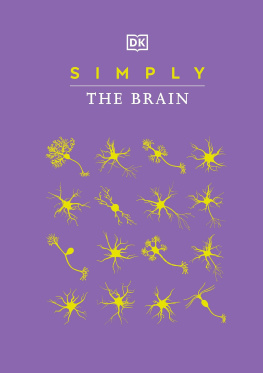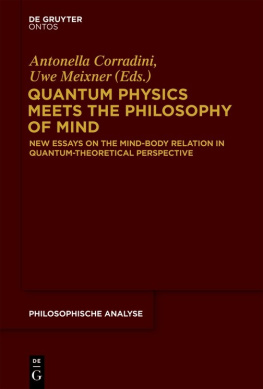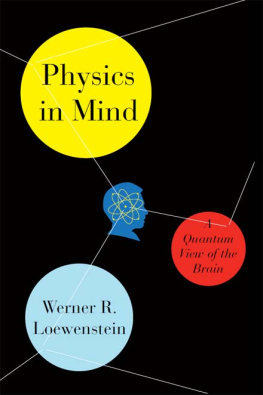Physics in Mind
Physics
in Mind
A Quantum View of the Brain

Werner R. Loewenstein
BASIC BOOKS
New York
A Member of the Perseus Books Group
Copyright 2013 by Werner R. Loewenstein
Published by Basic Books,
A Member of the Perseus Books Group
All rights reserved. No part of this book may be reproduced in any manner whatsoever without written permission except in the case of brief quotations embodied in critical articles and reviews. For information, address Basic Books, 250 West 57th Street, 15th Floor, New York, NY 10107.
Books published by Basic Books are available at special discounts for bulk purchases in the United States by corporations, institutions, and other organizations. For more information, please contact the Special Markets Department at the Perseus Books Group, 2300 Chestnut Street, Suite 200, Philadelphia, PA 19103, or call (800) 810-4145, ext. 5000, or e-mail .
Designed by Trish Wilkinson
Set in 11.5 point Minion Pro
Library of Congress Cataloging-in-Publication Data
Loewenstein, Werner R.
Physics in mind : a quantum view of the brain / Werner R. Loewenstein.
p. cm
Includes bibliographical references and index.
ISBN 978-0-465-03397-3 (e-book)
1. Neurophysiology. 2. Neural networks (Neurobiology) 3. Brain. I. Title.
QP355.2.L64 2013
10 9 8 7 6 5 4 3 2 1
To my children, Claudia, Patricia, Harriet, and Stewart
Contents
Wresting Information from Entropy:
The Quintessence of Cognition
The Demons Behind Our Pictures in the Mind:
A Darwinistic Physics View
Electronic Information Transmission:
A Development Stumped
The Evolutionary Niche in the Structure of Time:
A Hypothesis
Why Our Weltanschauung Is So Narrow:
An Unexpected Lesson for Philosophy
The radio was on in the background when I became aware of some vaguely familiar chords. As I began to listen more intently, a few swells of harmony pushed a button somewhere: Bach, the chorale Out of the Deep, the faint final accords.
I hadnt heard that piece in decades. But as a teenager I had sung it in the school choir. Hearing those notes, I remembered the music and words of the entire chorale, as well as the withering look of the conductor when I missed my cue and yes, the face of that girl in the choir I had fancied.
A melody, a face, the sounds of rushing wind, the smell of honeysuckle, the touch of a hand long stillall this we can perceive with the minds eye. We see, we hear, we feel, we remember, we are aware.
But what precisely do we mean when we say, We are aware of something? What is this peculiar state, at once so utterly familiar and so bewilderingly mysterious, that we call consciousness? What is its mechanism?
I put it like that point blank, to show from the start the tenor of the way and hold implicitly forth the expectation that consciousness has a physics explanation. Such a prospect may be shocking to some. That our mind and perceptions, our joys and sorrows, our memories, our sense of self, or worse, the glittering jewel of human intellect, thought, could be reduced to physics terms, may be a blow to ones self-esteem. But it is really no more so than anything evolutionaryDarwinian schemes always step on the peacock tail.
In any case, that prospect should no longer be as shocking as it might have been, say, 20 years ago. In the meantime, the neurosciences have advanced on a broad front, only to bolster reductionist aspirations. The advances have held up the mirror to the brain, its intricate web of a trillion neurons, letting us see in detail as never before the stream of information that nurses our perceptions and the information processing that precedes them.
I wrote this book in an attempt to make these advances accessible to a wide spectrum of readers. I center on the information processing that takes place at the sensory periphery of the brain and at the brain cortex and examine it in the light of information theory. I have been fortunate that in the past few years there has been a major breakthrough in an offspring of that theory, quantum computation; the most spectacular advances happened just as I penned the last three chapters. So I was able to view the sensory information processing in this new light, especially the parallel processing that is the hallmark of the cognitive brain. That processing is the antecedent of consciousness and is exquisitely sensitive and fast, offering a target to test ones reductionist mettle.
I originally intended to limit my story to the brains sensory periphery, to the capture and transfer of information at sensory receptors, a field I had worked in early in my career. But as I went on with the story, my leading characters, a set of talented biological molecules, started to develop wills of their own and did things quite different from those I had planned for them. Well, I should have been forewarned. Those are molecules operating by the strange rules of quantum logic. And in no time they took over the brains ground floor, the quantum bottom, presenting a tableau in which the boundaries between biology and physics vanished into thin air. That was a sight I could not resist. So this became a book on the sensory brain outright.
The book is written for the general reader with an interest in science. No specialized knowledge of biology, physics, or information theory is assumed in advance. With the general reader in mind, I have dispensed with mathematical apparatus. The few equations I used are tucked away in a footnote and the appendix. But the reader who wishes to skip them will not lose the thread of the book; the concepts they embody are explained in plain language along the way.
I have taken the liberty to personify throughout the book the process of biological evolution. I hope the reader wont mind. Such a personification comes naturally if one looks at things from the information angle. It simplifies the narrative of an evolutionary process that is rare, if not unique, in the physics universe, where the good throws of the dice neednt be repeated over and over againan evolutionary process that generates its own information repository to progressively reduce the element of chance.
It may be surprising that in a book on brain and mind there should appear more physicists than biologists. This merely reflects the fact that the mind is frontier territory. Indeed, it is not at all uncommon in biological history to find physical scientists at the leading edges. Even Darwin, contrary to popular belief, was originally not a biologist, or at least he didnt think of himself as one when he set out on the voyage of the Beagle: I a geologist have illdefined [sic] notion of land covered with ocean, former animals, slow force cracking surface... , he wrote in his notebook. Nor did things change very much in that regard a century later, when modern biology was well on its way and molecular genetics was still a territory of uncharted wonders. Then again physicists were among the pioneers. And an encore is happening these days as the mind is becoming the new frontier. Indeed, the brain-mind problem, a subject that for centuries had been lying uneasily at the border of science and philosophy, may be the natural meeting ground between biologists and physicists.
Some years ago a group of students and colleagues of mine at Columbia University staged a mock biophysics symposium on my birthday. The symposium was an elaborate spoof on the vagaries of biophysics and the crowings of its practitioners. It was great fun, though much of it I have forgotten. But not the refrain of one of the ditties, and it has been haunting me ever since: Biology is biology, and physics is physics, and never the twain shall meet. If this book helps to sink that refrain into oblivion, that is the best I would ask for.
Next page














